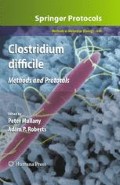Abstract
Members of the genus Clostridium have long been recognised as important to humankind and its animals, both in terms of the diseases they cause and the useful biological processes they undertake. This has led to increasing efforts directed at deriving greater information on their basic biology, most notably through genome sequence. Accordingly, annotated sequences of all of the most important species are now available. However, full exploitation of the data generated has been hindered by the lack of mutational tools that may be used in functional genomic studies. Thus, the number of clostridial mutants generated has until recently been disappointingly small. In particular, the construction of directed mutants using classical homologous recombination-based methods has met with only limited success. Moreover, most of these few mutants were constructed by the unstable integration of a plasmid into the chromosome via a single crossover event. As an alternative, recombination-independent strategies have been devised that are reliant upon a re-targeted group II intron. One element in particular, the ClosTron, provides the facility for the positive selection of insertional mutants. The generation of mutants using the ClosTron is extremely rapid (as little as 10 days) and is highly efficient and reproducible. Furthermore, the insertions made are extremely stable. Its deployment has considerably expanded available options for clostridial functional genomic studies.
Access this chapter
Tax calculation will be finalised at checkout
Purchases are for personal use only
References
Mohr G, Smith D, Belfort M and Lambowitz AM. (2000) Rules for DNA target-site recognition by a lactococcal group II intron enable retargeting of the intron to specific DNA sequences. Genes Dev 14, 559–573.
Perutka J, Wang W, Goerlitz D and Lambowitz AM. (2004) Use of computer-designed group II introns to disrupt Escherichia coli DExH/D-box protein and DNA helicase genes. J Mol Biol 336, 421–439.
Karberg M, Guo H, Zhong J, Coon R, Perutka J and Lambowitz AM. (2001) Group II introns as controllable gene targeting vectors for genetic manipulation of bacteria. Nat Biotechnol 19, 1162–1167.
Zhong J, Karberg M and Lambowitz AM. (2003) Targeted and random bacterial gene disruption using a group II intron (targetron) vector containing a retrotransposition-activated selectable marker. Nucleic Acids Res 31, 1656–1664.
Chen Y, McClane BA, Fisher DJ, Rood JI and Gupta P. (2005) Construction of an alpha toxin gene knockout mutant of Clostridium perfringens type A by use of a mobile group II intron. Appl Environ Microbiol 71, 7542–7547.
Heap JT, Pennington OJ, Cartman ST, Carter GP and Minton NP. (2007) The ClosTron: a universal gene knock-out system for the genus Clostridium. J Microbiol Methods 70, 452–464.
Purdy D, O’Keeffe TA, Elmore M, Herbert M, McLeod A, Bokori-Brown M, Ostrowski A and Minton NP. (2002) Conjugative transfer of clostridial shuttle vectors from Escherichia coli to Clostridium difficile through circumvention of the restriction barrier. Mol Microbiol 46, 439–452.
Hussain HA, Roberts AP and Mullany P. (2005) Generation of an erythromycin-sensitive derivative of Clostridium difficile strain 630 (630Deltaerm) and demonstration that the conjugative transposon Tn916DeltaE enters the genome of this strain at multiple sites. J Med Microbiol 54, 137–141.
Theys J, Pennington OP, Dubois L, Anlezark G, Vaughan T, Mengesha A, Landuyt W, Anné J, Burke PJ, Dûrre P, Wouters BG, Minton NP and Lambin P. (2006) Repeated cycles of Clostridium-directed enzyme prodrug therapy result in sustained antitumour effects in vivo. British J Cancer 95, 1212–1219.
Mermelstein LD and Papoutsakis ET. (1993) In vivo methylation in Escherichia coli by the Bacillus subtilis phage_ 3T I methyltransferase to protect plasmids from restriction upon transformation of Clostridium acetobutylicum ATCC 824. Appl Environ Microbiol 59, 1077–1081.
Mauchline ML, Davis TO and Minton NP. (1999) Clostridia. In: Demain AL, Davies JE eds., Manual of Industrial Microbiology and Biotechnology, ASM Press, Herndon, VA, pp. 475–492.
Davis TO, Henderson I, Brehm JK and Minton NP. (2000) Development of a transformation and gene reporter system for group II, non-proteolytic Clostridium botulinum type B strains. J Mol Microbiol Biotechnol 2, 59–69.
Zhou YT and Johnson EA. (1993) Genetic transformation of Clostridium botulinum Hall A by electroporation. Biotechnol Lett 15, 121–126.
Heap JT, Kuehne SA, Ehsaan M, Cartman ST, Cooksley CM, Scott JC, Minton NP. (2010) The ClosTron: Mutagenesis in Clostridium refined and streamlined. J Microbiol Methods 80, 49–55.
Acknowledgements
The authors wish to acknowledge the financial support of the BBSRC (grants BB/D522797/1, BD/D522289/1 BB/F003390/1), the MRC (G0601176) and SysMO (project number 2; http://www.sysmo.net).
Author information
Authors and Affiliations
Editor information
Editors and Affiliations
Rights and permissions
Copyright information
© 2010 Springer Science+Business Media, LLC
About this protocol
Cite this protocol
Heap, J.T., Cartman, S.T., Kuehne, S.A., Cooksley, C., Minton, N.P. (2010). ClosTron-Targeted Mutagenesis. In: Mullany, P., Roberts, A.P. (eds) Clostridium difficile. Methods in Molecular Biology™, vol 646. Humana Press. https://doi.org/10.1007/978-1-60327-365-7_11
Download citation
DOI: https://doi.org/10.1007/978-1-60327-365-7_11
Publisher Name: Humana Press
Print ISBN: 978-1-60327-364-0
Online ISBN: 978-1-60327-365-7
eBook Packages: Springer Protocols

